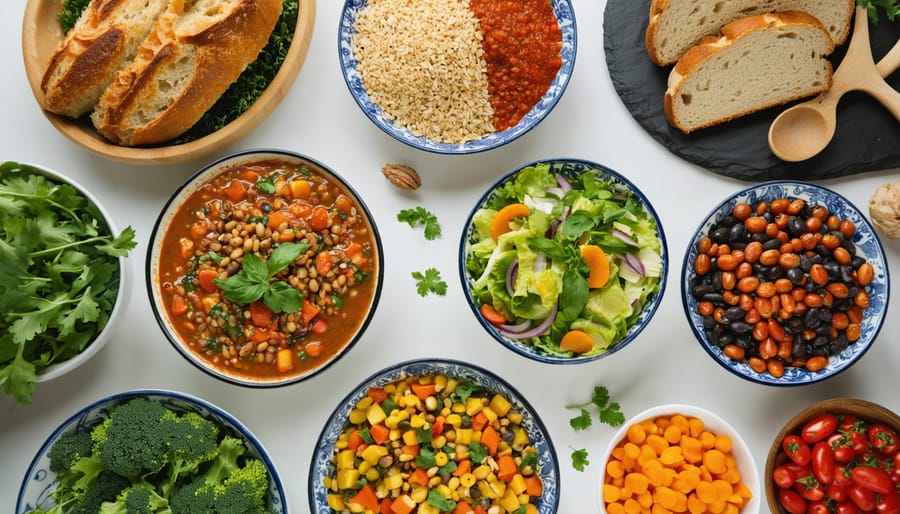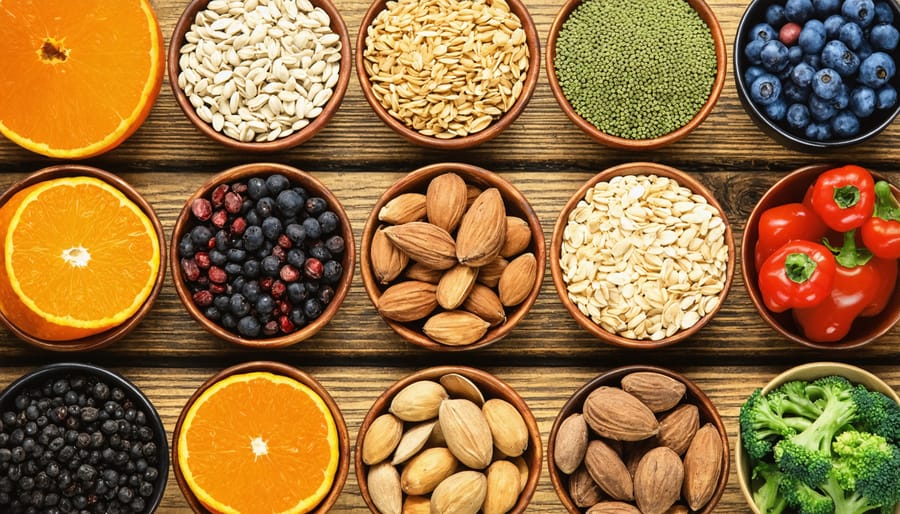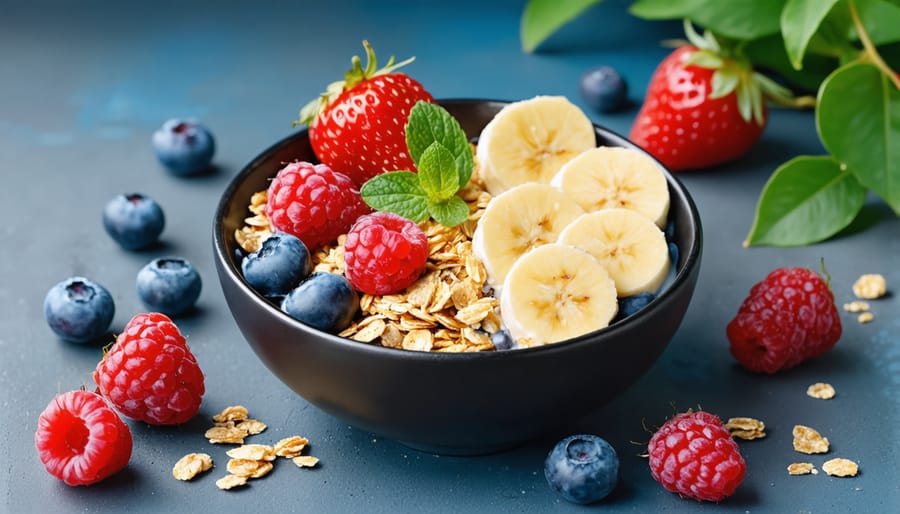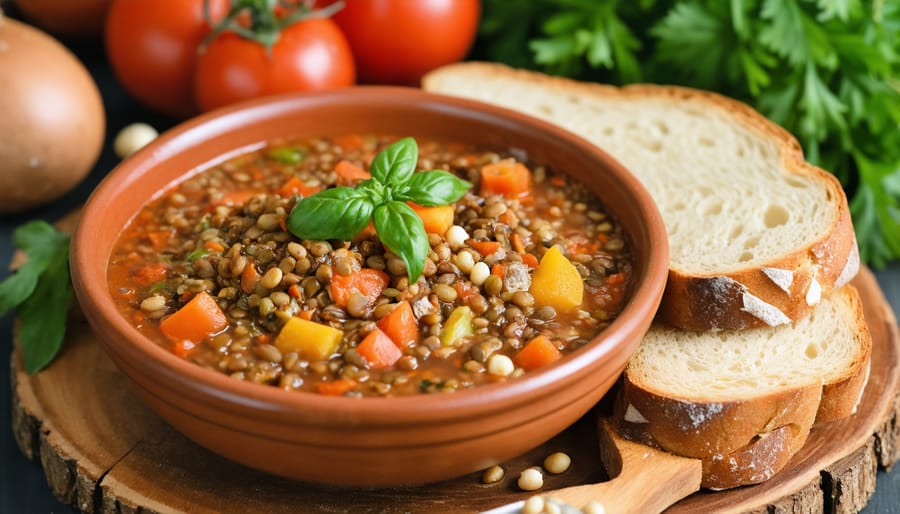
Discover the vibrant world of Seventh-day Adventist cooking, where wholesome plant-based ingredients transform into nourishing, flavorful meals that energize both body and spirit. Taking a mindful approach to eating, these time-tested recipes embrace the principles of clean, compassionate living while delivering impressive nutritional benefits.
From hearty lentil loaves to creamy cashew-based sauces, Adventist cuisine proves that plant-forward cooking can be both satisfying and delicious. Whether you’re following Adventist dietary guidelines or simply seeking healthier meal options, these recipes offer a perfect blend of tradition and modern nutrition science. Each dish celebrates the abundance of whole grains, legumes, fresh produce, and nuts – ingredients that not only support optimal health but also create memorable, satisfying meals that bring families together.
Let’s explore these kitchen-tested recipes that have nourished generations of Adventist families, bringing their time-honored cooking wisdom into your modern kitchen. Get ready to discover why this wholesome approach to cooking has gained recognition worldwide for promoting longevity and wellness.
The Foundations of Adventist Cooking

Essential Pantry Ingredients
Stocking your pantry with the right ingredients is essential for creating delicious Seventh-day Adventist meals. As someone who’s been cooking plant-based dishes for years, I’ve found these staples to be absolutely indispensable.
Start with a variety of whole grains like brown rice, quinoa, and oats. These form the foundation of many nutritious meals and are packed with fiber and nutrients. Keep an assortment of dried beans and lentils on hand – they’re not only budget-friendly but also excellent sources of protein.
Your pantry should include nuts and seeds such as almonds, walnuts, flax seeds, and chia seeds. These add texture and healthy fats to your dishes. Don’t forget to stock up on nutritional yeast, which adds a wonderful cheesy flavor to vegan dishes.
For seasoning, maintain a collection of herbs and spices like cumin, turmeric, basil, and oregano. Plant-based broths, coconut milk, and tomato products are crucial for creating flavorful sauces and soups. Finally, keep whole grain flour, maple syrup, and dates for healthy baking alternatives.
Remember, these ingredients aren’t just nutritious – they’re versatile building blocks for creating satisfying, wholesome meals that align perfectly with Adventist dietary principles.
Kitchen Tools and Equipment
To create delicious and nutritious Adventist meals, you’ll want to stock your kitchen with some essential tools. A high-powered blender is invaluable for making smoothies, plant-based sauces, and creamy soups. I’ve found that investing in a quality food processor also makes quick work of chopping vegetables and preparing homemade nut butters.
For whole-grain baking, keep measuring cups and spoons, mixing bowls, and sturdy baking sheets on hand. A good set of sharp knives is essential for preparing fresh produce, while a rice cooker can be a lifesaver for perfectly cooked grains. Don’t forget about basic items like colanders for washing produce and straining, and glass storage containers for keeping your ingredients fresh.
If you’re serious about plant-based cooking, consider adding specialized tools like a spiralizer for vegetable noodles, a steamer basket for perfectly cooked vegetables, and a tofu press. Many of my readers also swear by their instant pot for quick-cooking beans and legumes. Remember, you don’t need everything at once – start with the basics and build your collection as you explore more recipes.
Breakfast Recipes
Granola and Breakfast Cereals
Start your day the Adventist way with homemade granola and breakfast cereals that are both nourishing and delicious. One of my favorite morning traditions is creating batches of maple-sweetened granola packed with wholesome ingredients like rolled oats, nuts, and dried fruits. The wonderful aroma of toasting oats and honey filling your kitchen makes the effort absolutely worth it!
A classic Adventist granola combines rolled oats, chopped almonds, sunflower seeds, and coconut flakes, lightly sweetened with honey or maple syrup. For added nutrition, you can incorporate wheat germ, ground flaxseed, or chia seeds. The beauty of making your own granola is that you can customize it to your taste while keeping it free from refined sugars and preservatives.
For a simpler breakfast option, try the traditional Adventist breakfast cereal mix of rolled oats, chopped dates, and banana slices, topped with plant-based milk. Many Adventist families also enjoy muesli, which doesn’t require baking – simply mix raw oats with nuts, seeds, and dried fruits, then serve with your choice of milk or yogurt.
Remember to make larger batches of granola that you can store in airtight containers for up to two weeks, making your healthy breakfast routine even more convenient.

Hot Breakfast Options
Start your day with these nourishing and satisfying hot breakfast options that align perfectly with Adventist dietary principles. A warm bowl of steel-cut oats topped with fresh berries, maple syrup, and chopped nuts provides lasting energy for busy mornings. If you prefer a make-ahead option, try these delicious overnight oats that can be gently warmed in the morning.
For a protein-rich start, consider creamy quinoa porridge sweetened with dates and a splash of plant-based milk. Top whole grain toast with mashed avocado, sliced tomatoes, and a sprinkle of nutritional yeast for a savory option that’s both filling and nutritious. Another favorite is whole wheat English muffins topped with almond butter and banana slices, drizzled with a touch of local honey.
Don’t forget about warming breakfast classics like cornmeal porridge seasoned with cinnamon and vanilla, or hearty multi-grain hot cereal mixed with applesauce and crushed walnuts. These options not only provide essential nutrients but also bring comfort and satisfaction to your morning routine while staying true to plant-based Adventist principles.
Main Course Dishes
Legume-Based Dishes
Legumes are a cornerstone of Seventh-day Adventist cooking, offering both incredible nutrition and versatile meal options. One of my favorite go-to recipes is the hearty Three-Bean Chili, which combines kidney beans, black beans, and pinto beans with fresh vegetables and warming spices. It’s perfect for those chilly evenings when you need something substantial yet wholesome.
For a quick weekday lunch, try our Mediterranean Lentil Salad. Simply combine cooked green lentils with diced cucumbers, tomatoes, and red onions, then dress with olive oil and lemon juice. This protein-rich dish keeps well in the fridge, making it ideal for meal prep.
Chickpea curry has become a community favorite at our potlucks. The creamy coconut-based sauce, infused with turmeric and ginger, transforms ordinary chickpeas into an exotic feast. Serve it over brown rice for a complete meal that’s both satisfying and nutritious.
Don’t overlook the humble split pea soup! Our version includes carrots, celery, and herbs, creating a comforting bowl that’s both budget-friendly and filling. For added variety, try rotating different legumes in your favorite recipes – navy beans work wonderfully in homemade baked beans, while black-eyed peas make delicious Southern-style stews.
Remember to soak your dried beans overnight to reduce cooking time and improve digestibility. Your body will thank you for incorporating these protein-packed powerhouses into your weekly meal rotation!

Whole Grain Entrees
One of my favorite aspects of Adventist cooking is how creatively we incorporate whole grains into satisfying main dishes. Quinoa-stuffed bell peppers are a colorful crowd-pleaser, combining protein-rich quinoa with fresh vegetables and herbs. The peppers become naturally sweet when roasted, creating a perfect vessel for the wholesome filling.
For a heartier option, try our beloved brown rice and lentil loaf. This wholesome entrée brings together earthy lentils, nutty brown rice, and a medley of seasonal vegetables. It’s wonderfully filling and makes excellent leftovers for lunch the next day.
Whole wheat pasta dishes also feature prominently in Adventist cooking. Our Mediterranean-style whole grain penne combines cherry tomatoes, spinach, and chickpeas for a protein-packed meal that comes together in under 30 minutes. For something different, barley risotto with mushrooms and root vegetables offers a comforting twist on the traditional Italian dish.
Don’t overlook the humble bulgur wheat! It makes an excellent base for veggie-packed grain bowls. My personal favorite combination includes roasted sweet potatoes, kale, and a tangy tahini dressing. These bowls are not only nutritious but also endlessly customizable based on what’s in season.
Remember, the key to delicious whole grain entrées is proper seasoning and fresh ingredients. These dishes prove that healthy eating can be both satisfying and delicious.
Side Dishes and Salads
Fresh Salads
Fresh salads are a cornerstone of Adventist cuisine, offering a burst of nutrients while staying true to plant-based principles. One of my community favorites is the Rainbow Quinoa Salad, which combines protein-rich quinoa with colorful bell peppers, cherry tomatoes, and a light lemon-herb dressing. It’s perfect for potlucks and warm summer gatherings!
For a heartier option, try the Mediterranean Chickpea Salad. I love tossing together crisp cucumber, red onions, and protein-packed chickpeas with a splash of olive oil and fresh herbs. This refreshing combination provides sustained energy throughout the day.
The Adventist Kitchen Garden Salad celebrates seasonal produce with a mix of leafy greens, shredded carrots, and whatever vegetables are flourishing in your garden. Top it with a handful of sunflower seeds and a simple apple cider vinaigrette for added nutrition and crunch.
Don’t forget about fruit-based salads! Our Citrus Avocado Salad pairs sweet oranges with creamy avocado on a bed of spinach, creating a perfect balance of flavors while providing essential healthy fats and vitamins.
Cooked Vegetable Sides
When it comes to nourishing vegetable sides, Seventh-day Adventist cuisine offers some truly delightful options that bring both comfort and nutrition to your plate. One of my family favorites is garlic-roasted Brussels sprouts, seasoned with a touch of olive oil and fresh herbs – they convert even the strongest Brussels sprout skeptics!
Steamed green beans almondine offers a perfect blend of crunch and tenderness, while roasted root vegetables tossed with rosemary and thyme bring warmth to any meal. I’ve found that adding a splash of lemon juice just before serving brightens up these dishes beautifully.
For something truly special, try our community’s beloved maple-glazed carrots, where the natural sweetness of the vegetables shines through. Another crowd-pleaser is the herb-roasted cauliflower with nutritional yeast, which adds a wonderful cheesy flavor while keeping things plant-based.
These sides work wonderfully for both everyday meals and special gatherings. The key is to let the natural flavors of the vegetables take center stage while enhancing them with simple, wholesome seasonings. Remember, the best vegetables are those prepared with love and shared with others!
Healthy Desserts
Fruit-Based Desserts
When it comes to satisfying your sweet tooth the Adventist way, fruit-based desserts are a delightful and wholesome choice. Fresh fruit cobblers made with seasonal peaches or berries bring natural sweetness to your table, while baked apples stuffed with dates and walnuts offer a warm, comforting treat. One of my family’s favorites is the classic mixed fruit compote, gently simmered with a touch of maple syrup and cinnamon.
For a quick dessert, try frozen banana “nice cream” – simply blend frozen banana chunks until creamy, adding a splash of plant-based milk if needed. Date rolls coated in coconut flakes make perfect portable treats, while fruit leather prepared from pureed fresh fruits offers a healthy alternative to store-bought candies. During summer gatherings, nothing beats a refreshing watermelon sorbet or a vibrant berry parfait layered with granola and coconut yogurt.
Baked Goods
Indulging in sweet treats doesn’t mean compromising on health when it comes to Adventist baking. These wholesome desserts use natural sweeteners and whole grain flours to create delightful treats that nourish both body and soul. Try our signature whole wheat banana bread, naturally sweetened with ripe bananas and a touch of maple syrup. Our oatmeal-date cookies are a perfect afternoon pick-me-up, packed with fiber and natural sweetness from dates.
For special occasions, the carob cake is a delicious alternative to chocolate, made with carob powder and applesauce for moisture. Don’t miss our celebrated zucchini muffins, which cleverly incorporate vegetables while maintaining a perfectly sweet taste. These recipes often use plant-based ingredients like flax eggs and coconut oil, staying true to Adventist principles while delivering on taste and texture.
Remember, successful vegan baking is all about balance – these recipes have been carefully tested to ensure they’re not only healthy but also absolutely delicious.
Incorporating these wholesome Seventh-day Adventist recipes into your weekly meal planning doesn’t have to be overwhelming. Start by choosing two or three recipes that appeal to you and your family, and gradually expand your repertoire as you become more comfortable with plant-based cooking.
A helpful approach is to designate specific days for trying new recipes – perhaps “Meatless Monday” or “Wellness Wednesday.” This creates a consistent routine while making the transition more manageable. Keep your pantry stocked with staples like legumes, whole grains, and nuts, so you’re always ready to prepare these nutritious meals.
Remember that meal prep is your friend! Many of these recipes can be made in larger batches and frozen for later use. Consider spending a few hours on Sunday preparing ingredients or complete meals for the week ahead. This not only saves time but also helps you stay committed to healthier eating habits.
Don’t feel pressured to make everything perfect from the start. It’s perfectly fine to modify recipes to suit your taste preferences or what’s available in your kitchen. The key is to embrace the journey toward more mindful, plant-based eating while maintaining joy in the cooking process.
Join online communities or local groups that share similar dietary interests – you’ll find endless inspiration and support from others who are on the same path. Remember, every small step toward healthier eating is a victory worth celebrating!



